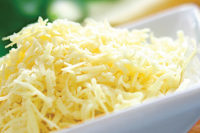Texture has always been an important attribute of foods and beverages. In fact, for some consumers, an adverse texture is enough for them to reject a food even before tasting it. This is because we not only use the sense of feeling in our mouths, or mouthfeel, to assess a food’s texture, we also create expectations of texture by visually evaluating a food. For example, a green banana might be too hard to eat, but a brown one will likely be mushy. However, for the most part, consumers don’t think about texture unless they find one to be objectionable.
Texturants to the rescue
About 20 years ago, food scientists had to start including texture goals in their product development endeavors. This is because prior to the fat-free frenzy of the early 1990s, characterizing calorically dense ingredients such as fat and sugar were not frequently manipulated in product formulations. Today, the only way to successfully reduce such ingredients, which is increasingly common in all food segments, is to rely on additives that manage and manipulate food textures.
Usually carbohydrate or protein based, this category of ingredients collectively known as texturants can impact the appearance and mouthfeel of foods, typically without contributing much in terms of calories and flavor. In dairy foods, select cultures can also contribute to finished product texture. For example, ropy cultures increase viscosity and gel stability in yogurt. And depending on the application, texturants can help manage ingredient costs by replacing more expensive ingredients such as milkfat.
A language of its own
Even though texture is a significant attribute in most dairy foods, formulators have historically overlooked its measure during the early stages of product development due to a lack of tools to evaluate and characterize texturant performance.
“What’s been missing until now is a systematic approach to achieving desired textural effects in food and drink,” according to Matt Patrick, vice president of research and development with a texturant supplier. “While texture is one of the most basic attributes of food sensory experiences, it has traditionally been an under-leveraged aspect of food product formulation. With no commonly accepted language for discussing it, descriptions of texture were vague at best.”
A number of suppliers have invested in the development of a texture vocabulary that enables formulators to better define texture targets, followed by an improved selection of texturants to achieve their goals. It is a powerful way of articulating texture to help formulators plan and describe the attributes that can provide finished food products with improved consumer acceptance.
“The industry now has a robust, globally relevant language to help product developers elevate texture to the equal of flavor in the formulation process,” says Joseph Light, the global head of development with a texturant supplier. “By translating what consumers like and dislike about food texture into scientific attributes whose intensity we can measure, we can make direct, rapid connections to a texture solution to support what we know will be an appealing finished product.”
By establishing a texture-focused language, formulators are able to address important texture issues through the whole sensory experience with a food product, from the first look through swallowing. “With a defined language to articulate the target texture and process for mapping it, delivering better products to customers sooner than later is now possible,” says Patrick.
Helen Simpson, a sensory manager with one of the suppliers, adds, “This language helps people understand the building blocks of a consumer-preferred texture in a range of applications. We now know that what a consumer calls ‘creamy’ is actually a multifaceted texture experience that results from differing intensities of at least 15 sensory and rheology attributes, such as mouthcoating, meltaway and oral viscosity. Understanding this gives us the ability to characterize various products by the specific, precise attributes that constitutes a creamy experience in a product such as yogurt, and plot them on a texture map. Our texture maps position commercial products on a map with texture attributes as the directional markers so we can easily see the texture similarities and differences. From there we can help our customers target and achieve the luscious smoothness consumers want.”
Having a texture language not only reduces product development times by taking the guesswork out of texturant selection, it also helps with keeping formulations clean and simple. This often translates to cost savings and an improved bottom line.
“When better texture is addressed earlier in the development process, it is possible to improve the way flavor is delivered and perceived,” says Patrick. “And manipulating texture is an economical way to deliver perception and product differentiation in a crowded marketplace.”
The historical approach to product development has been to identify a product concept, develop a prototype and evaluate it with consumers. Only after evaluation did the developer receive feedback on texture, and often in terms that were not consistent or well defined.
“By including texture at the very beginning of the product development process and using a well-defined descriptive language, it is easier to refine formulations after sensory evaluation,” says Patrick.
Beverage textures
As mentioned, consumers do not often think of texture unless they find it to be objectionable. And in a beverage such as iced tea, few would think texture even matters. A supplier at the Supply Side West International Trade Show and Conference in October showed attendees that it does.
When sugar is removed from infusions such as iced tea to make low- or no-calorie products, high-intensity sweeteners often replace the sweetness but cannot do much in terms of replacing the mouthfeel that accompanies dissolved sugar or corn syrup. Without the addition of texturant, the tea will seem thin and lack body. Lower viscosity in such beverages translates to the liquid clearing the palate very quickly with little flavor remaining in the mouth or on the tongue during or after swallowing. Consumers may have difficulty articulating what is missing from the drink, but their inclination not to make a repeat purchase of such products speaks volumes.
By careful selection of texturant, the formulator can recreate the experience of the sugar-sweetened beverage, but with fewer calories. Further, all types of beverage developers can generate significant innovation with new or reformulated products by changing the texture. Texturants can be used to manipulate texture either separately or in combinations. Each texture modifier will change the experience based on the type and amount of adaptation added.
For example, one supplier has been able to use natural flavors and a combination of texturants to build back flavor and texture in a 40% reduced-sugar chocolate milk that meets the USDA’s proposed school milk guidelines. The product has a mouthfeel that children have grown accustomed to in school chocolate milk.
Beverages, along with most dairy foods, benefit from the use of texturants. And now, product developers have the tools to formulate more efficiently.




